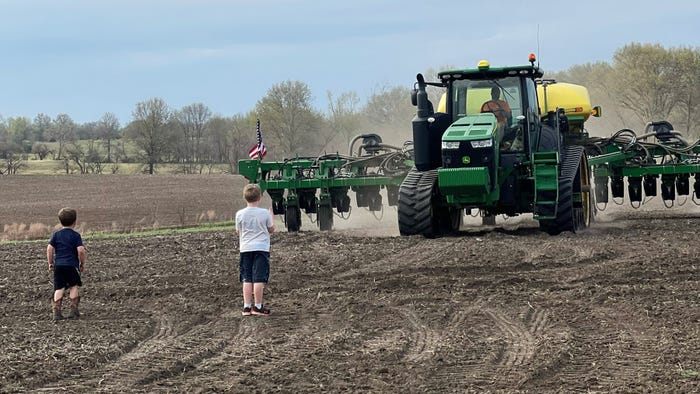March 22, 2023

by Olivia Loges
Mike Daniels knew achieving his goal of contest-winning soybean yields would take some blood, sweat and tears. What he didn’t realize was the need for multiple cases of 5-hour Energy drinks.
Daniels likes to spray soybeans at night, which doesn’t allow for a normal sleep schedule.
“Our thought process with spraying foliar feed at night is because the plants are more relaxed and their pores are open more, so the feed can get into the plant better,” he explains.
Staying up until 4 or 5 o’clock in the morning was by far the biggest sacrifice toward a successful soybean production year. Still, Daniels finds the results were worth it for him personally, his family and the farm’s future.
The Carroll County farmer won first place in the Missouri Soybeans Association yield contest with a 10-bushel yield advantage, raising 122 bushels per acre with nonirrigated, conventional tillage beans.

GET PLANTING: Last year, Mike Daniels planted the Pioneer P46A09E soybean variety and topped the Missouri Soybean Association’s yield contest with 122 bushels per acre on nonirrigated land. His sons love to be a part of all aspects of the farming operation from spring through harvest.
To put Daniels’ accomplishment into context, Missouri ranks seventh in the U.S. for soybean production and averages 48 bushels per acre, according to USDA. Daniels produced 2 ½ times the average state soybean yield.
Although his goal for the contest was to raise 125-bushel beans, there were still feelings of relief and excitement when the results were verified. “122 is nothing to shrug your shoulders at,” Daniels says proudly.
Contest-winning plan
With two years as a contestant under his belt, Daniels starts the growing season with a solid management plan.
After the 2021 fall harvest, he sprayed nitrogen on the stalks to break them down quicker, ensuring the soybeans planted in the spring of 2022 were supplied with as much nutrient-rich matter as possible.
Daniels credits his new, not-so-secret ingredient for higher yields — chicken litter. He applies several tons of litter every year, along with products such as Yield Topper, a liquified chicken litter from BigYield. Daniels admits this is becoming one of his more common soybean crop management practices to achieve maximum bushels per acre.

FAMILY FOCUS: Farm life requires family time in the tractor cab during planting and harvest. Soybean grower Mike Daniels (far right) is joined by his wife, Tamara, and surrounded by his sons (left to right) Bronson, Kelson and Lawson.
After prepping the field, in early April, Daniels planted a long maturing Pioneer P46A09E variety. Planting earlier and thicker than normal allowed the crop to not be affected as much by expected cold weather or dry spells, he adds. Treating soybeans was also key to protecting them.
Not only was there a game plan for planting soybeans, but Daniels also worked closely with an agronomist from Pioneer to develop an in-season strategy to gather information on how the soybeans were growing.
Every seven to 10 days, his agronomist drove to the field in between spraying to collect soil and tissue samples. They also installed equipment to measure moisture and ground temperature, which could be monitored from a remote location.
Drive to high yields
Daniels plans to continue researching new products, asking for advice from other farmers and industry professionals, and using a trial-and-error process to produce high soybean yields. He believes it is the perfect approach to achieve success.
Being a sixth-generation farmer, Daniels farms with his dad and three sons — Bronson, Lawson and Kelson. He is proud of the next generation for taking an interest in the operation and learning alongside him. Their interest fuels the future of the family farm.
“Our goal next year is 150 [bushels per acre],” Daniels says.
Loges writes from Higginsville, Mo.
You May Also Like




